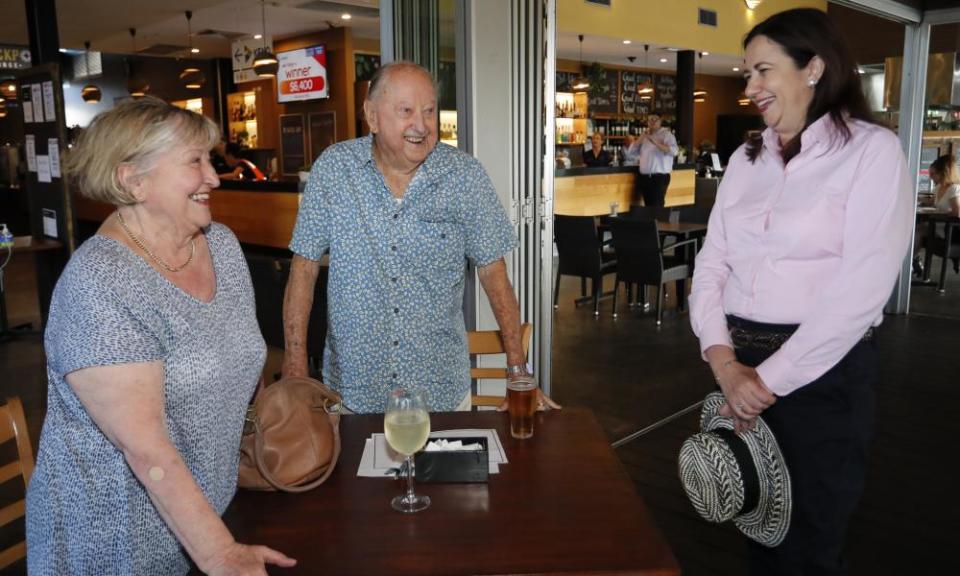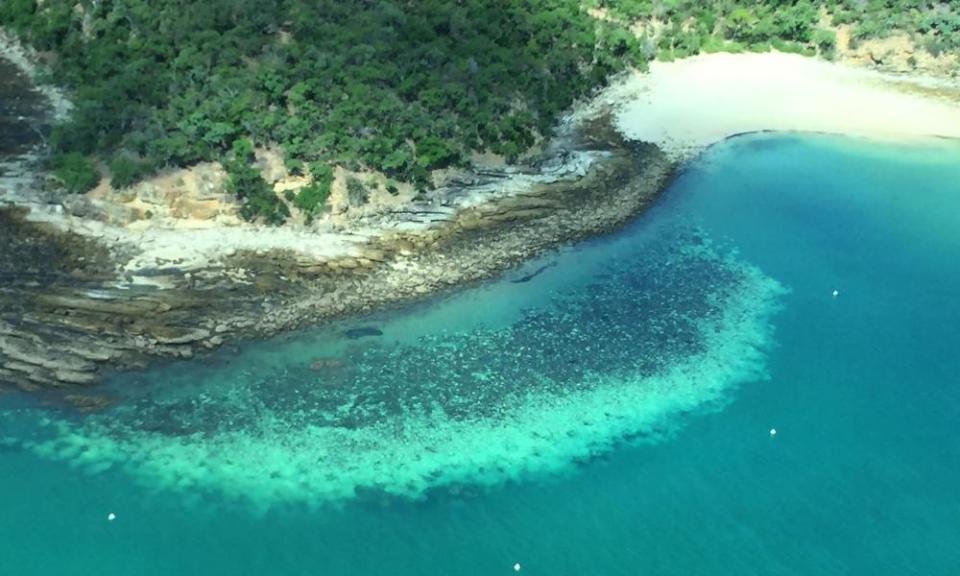Complexities and contradictions: making sense of Queensland's election

Welcome back to Queensland.
The last time voters in the Sunshine State were the focus of the nation – the 2019 federal election – #Quexit and #MakeThemLeave became trends on social media.
The closed state border has reinforced that sort of baffled view from south of Tweed Heads about Queensland politics.
Related: Has anyone seen Pauline? 10 things we learned from the Queensland election campaign
Understanding Saturday’s state election is, in part, about understanding the complexities and contradictions of Queensland.
The state is a bucket-list destination for people around the world – home to one of the most visible victims of climate change, the Great Barrier Reef, and the hub to one of the planet’s biggest fossil fuel export operations.
The path to an election victory in Queensland relies on bringing together voters on all sides of some of Australia’s most divisive issues. Here is how the campaign played out.
A unique election
A full picture of the election result may not emerge until late on election night – or even for days afterwards. Voters in Townsville might swing in the opposite direction to those in the inner-Brisbane suburb of Toowong.
The likelihood of a minority government has increased significantly since the start of the state election campaign, analysts say, as both major parties find themselves with narrowing paths to an outright victory.
• Party insiders say minority government is increasingly likely
Of course, the parties are targeting certain seats they believe will be key to winning government. But while no seat can tell the statewide story, some offer clues to which side is winning the game of electoral chess.
• Seats to watch as parties play a game of electoral chess
At the heart of the campaign has been “the Queensland paradox” – the need to sometimes woo voters with different messages in different parts of the state.
“What the major parties share, although the challenges are different, is significant difficulty appealing to voters in metropolitan areas as well as those in the regions,” says University of Queensland political scientist Glenn Kefford.
“They’re different in terms of geography and income. They’re difficult attitudinally, in terms of their views and beliefs about what governments should do.”
• ‘Queensland paradox’ pushes coal and climate to centre stage
And of course, the campaign has been defined from the beginning by the coronavirus.
• Can Annastacia Palaszczuk hold on to ‘fortress Queensland’ in the Covid election?
The presidential election
One of the effects of the pandemic is that the campaigns of Labor and the LNP have focused on their leaders – the first federal or state election in Australia where two women lead the major parties.

The premier, Annastacia Palaszczuk, is campaigning to win a third term. Her political success – since being dubbed the “accidental premier” in 2015 – has gone some way to negating the typical politics of gender that hampered former female leaders.
• Has Palaszczuk helped defeat the politics of gender?
At the outset of the campaign, Palaszczuk’s popularity and her stance on the coronavirus border closures made her a target of attacks from opponents, who sought to characterise her as “heartless”.
• LNP gambles by targeting premier
Shifting sands
Amid the broader story at this election, political sands are shifting in the state. Labor has had to defend heartland territory in regional and largely working class cities. At the same time, LNP heartland areas of the Gold Coast and Sunshine Coast are in play.
• Shifting sands: Queensland sees red in blue-ribbon seats
The most-watched seat contest will be in South Brisbane where polling shows Jackie Trad, the prominent former deputy premier and treasurer, is likely to lose her seat to the Greens.
• Jackie Trad still gets under LNP’s skin even as she faces losing seat
And a politician who has often clashed with Trad, the ultraconservative LNP MP Mark Robinson, is also fighting to return to parliament. The Toondah Harbour development and a viable moderate independent, Claire Richardson, have upended the contest in the electorate of Oodgeroo, which has been compared to the Sydney northern beaches seat of Warringah at the 2019 federal election.
• How an independent could topple LNP incumbent
Lies, damned lies and job statistics
Of course, where would Queensland be without mining? The mining industry lobby has run a prominent third-party election campaign to draw attention to the jobs created by the industry.
But economists say the numbers are “bogus” and mining grossly overstates its contribution to Queensland.
• Why the resources council’s jobs figures don’t pass ‘the laugh test’

Jobs have been a consistent focus of the election campaign. Most days the premier and opposition leader have worn hi-vis to announce job creation plans as they toured the state.
At the same time, experts, economists and others have warned that “not everyone wants to swing a shovel” and that there is far greater economic value in supporting jobs creation in social service industries. There is also concern that women have been hardest hit by the pandemic, but that plans announced by the major parties don’t do enough to support pink-collar jobs.
• ‘Not everyone wants to swing a shovel’: jobs plans miss the mark
Crime and embellishment
Townsville has three seats and became the focus of the election campaign in the second-to-last week, when the LNP announced plans for a youth curfew – based on ideas from a public forum – that was criticised by criminologists, local community leaders and human rights advocates.
• Youth curfew plan risks violence against Indigenous children
The notion of a youth crime wave in Townsville has been a consistent theme in the local media – and on anti-crime Facebook pages – for the past decade.
That perception has fuelled ineffective “tough on crime” policies from most parties. The statistics, however, suggest the notion of a crime crisis is exaggerated.
• How a local ‘myth’ about crime could swing the election
An iconic natural environment, a second-tier issue
At a time when three of Australia’s biggest coal customers – China, South Korea and Japan – have committed to net zero emissions targets, any conversation in Queensland about the need for a just transition policy to support coalminers and their communities is reframed as political poison.

To outsiders, Queensland has “the biggest reef, the cutest critters and the whitest sands”, but many voters are apathetic to environmental concerns and the state’s politics are stuck in an adversarial cul-de-sac.
• The environmental issues at stake in the election
Experts say the state is likely to miss its 2030 climate target – 50% of energy generated by renewables. The LNP plans to scrap the target entirely.
Analysis commissioned by the Queensland Conservation Council shows renewables could mean a significant increase in jobs.
• Transition to renewables would generate almost 10,000 jobs
Christian soldiers and the push for social reform
Palaszczuk put voluntary assisted dying on the election agenda at the party’s campaign launch by promising a vote on proposed legislation early next year.
• Labor pledges to allow vote on voluntary assisted dying
Social reform has been an effective way for Labor to highlight some of the more extreme elements of the LNP, which has a large conservative Christian faction. Last month, an LNP frontbencher, Christian Rowan, gave an “iron clad agreement” to a conservative online chat show host the LNP would wind back the state’s 2018 abortion laws.
• LNP tries to keep anti-abortion push out of sight
The yellow billboards are back
The biggest spender this election – on social media, print ads, billboards, the works – has been Clive Palmer, whose United Australia Party has played the spoiler again. It is considered little chance of winning a seat, but is publishing unsubstantiated claims about Labor.
• Clive Palmer pumps $4.6m into his spoiler political party
Questions over donors
In the middle of the campaign, the ABC revealed that fundraisers featuring the LNP leader, Deb Frecklington, had been referred to the electoral watchdog by her own party. The story overshadowed her campaign events for several days.
• LNP leader says the party did not accept money from prohibited donors

